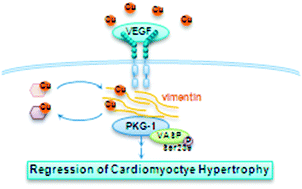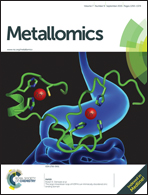The involvement of vimentin in copper-induced regression of cardiomyocyte hypertrophy†
Abstract
Dietary copper supplementation reverses the pressure overload-induced cardiac hypertrophy. Activation of vascular endothelial growth factor receptor-1 (VEGFR-1) and cyclic guanosine monophosphate (cGMP)-dependent protein kinase-1 (PKG-1) is required for the regression. The present study was undertaken to determine the link between VEGFR-1 and PKG-1 in copper regression of cardiomyocyte hypertrophy. Human cardiac myocytes (HCM) or primary cultures of neonatal rat cardiomyocytes were exposed to phenylephrine (PE) at a final concentration of 100 μM for 48 h to induce cell hypertrophy. Copper sulfite was added to cultures of hypertrophic cardiomyocytes at a final concentration of 5 μM elemental copper and incubated for 24 h to reverse cell hypertrophy. Liquid chromatography-tandem mass spectrometry (LC-MS/MS) analysis identified a 56 kDa copper-binding protein, vimentin, which was co-immunoprecipitated with VEGFR-1 and PKG-1. Copper supplementation increased vimentin levels and enhanced PKG-1 activity. Gene silencing using siRNA targeting vimentin prevented copper-induced elevation of vimentin, depressed the activity of PKG-1, and blocked the copper-induced regression of cardiomyocyte hypertrophy. This study demonstrates that vimentin is critically involved in the VEGFR-1 mediated activation of the PKG-1 signaling pathway, leading to regression of cardiomyocyte hypertrophy.


 Please wait while we load your content...
Please wait while we load your content...